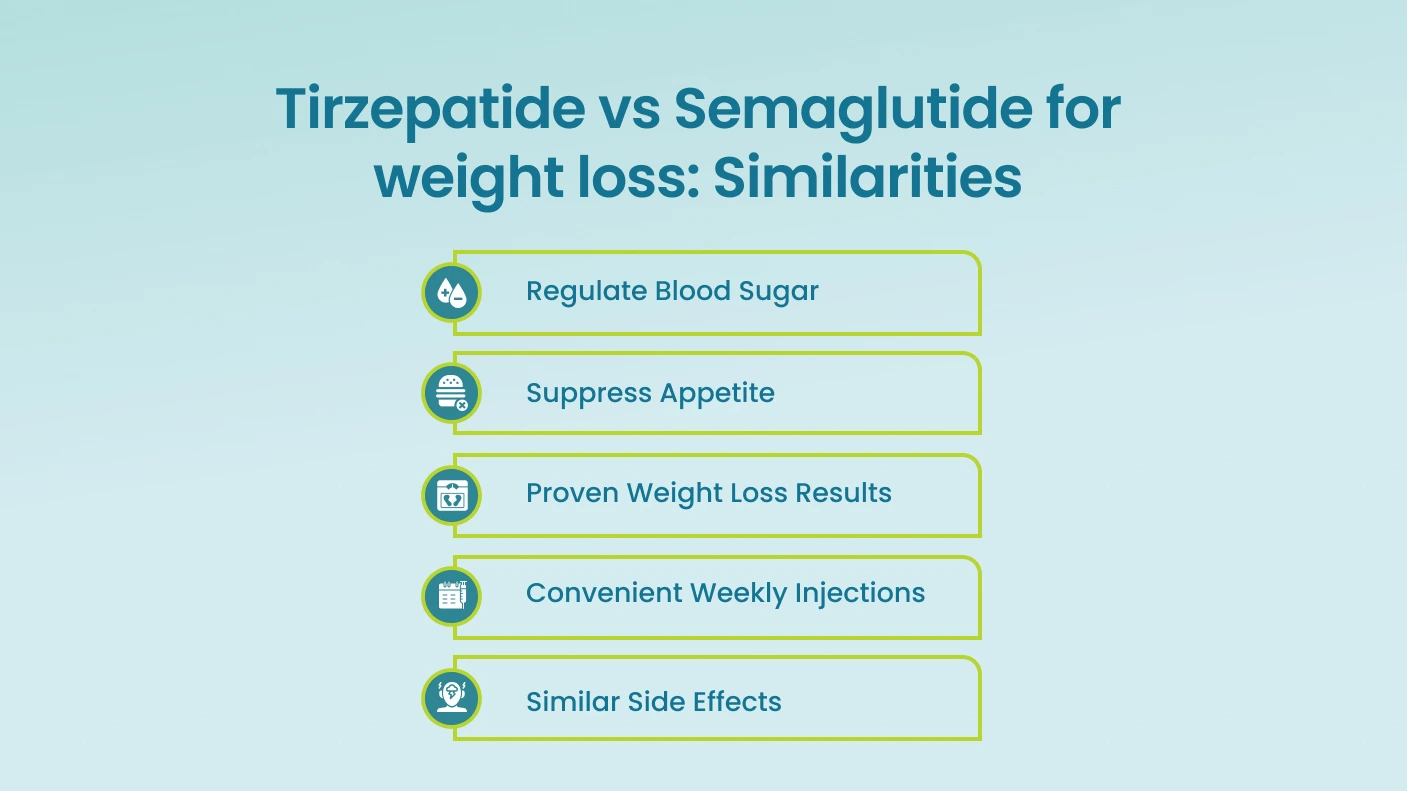
Tirzepatide vs Semaglutide for Weight Loss: Cost, Side Effects, & Dosage
More than 2.5 billion adults globally are overweight, and over 890 million are living with obesity, a significant risk factor for type 2 diabetes. This condition, linked to excess weight and unhealthy lifestyle habits, is a growing global health concern. The World Health Organization highlights obesity as the primary driver of type 2 diabetes, emphasizing the urgency of effective management strategies.
Innovative medical treatments like semaglutide and tirzepatide, initially developed to manage type 2 diabetes, have become leading treatments for obesity due to their proven effectiveness in promoting weight loss. With the World Obesity Federation projecting that nearly 4 billion people will be overweight or obese by 2035, understanding these treatments becomes crucial.
In this blog, we will compare tripeptide and semaglutide in detail, focusing on their effectiveness, side effects, costs, and recommended dosages. We’ll provide comprehensive insights to help you decide which treatment option best fits your needs.
An Overview of Semaglutide and Its Types
Semaglutide is a glucagon-like peptide-1 (GLP-1) receptor agonist that manages appetite and blood sugar levels. Semaglutide helps individuals lose an average of 14.9% of their body weight over 68 weeks. By mimicking the body’s natural hormones, it slows gastric emptying, reduces hunger, and increases feelings of fullness, making it a highly effective treatment for weight loss and type 2 diabetes management.
Brand Products
Ozempic®: A widely used injectable medication for type 2 diabetes that also promotes weight loss as a secondary benefit.
Rybelsus®: An oral version of semaglutide for managing type 2 diabetes, offering an alternative for those who prefer pills over injections.
Wegovy®: Specifically approved for chronic weight management in individuals with obesity or those who are overweight with related health conditions.
Semaglutide has received FDA approval for treating type 2 diabetes under the brand names Ozempic and Rybelsus. However, Wegovy is the only semaglutide-based medication specifically approved for weight management. Nonetheless, healthcare providers may prescribe Ozempic or Rybelsus off-label to support weight loss based on individual patient needs and comprehensive medical assessments.
An Overview of Tirzepatide and Its Types
Tirzepatide is an antidiabetic medication that activates GLP-1 and glucose-dependent insulinotropic polypeptide (GIP) receptors. Its unique dual-action mechanism produces even greater outcomes, delivering weight loss of 15% to 20% over 72 weeks, depending on the dosage. This dual-action mechanism enhances insulin secretion, reduces hunger, slows digestion, and promotes a feeling of fullness, making it highly effective for weight loss and type 2 diabetes management.
Brand Products
Mounjaro®: Approved for type 2 diabetes, this medication offers the added benefit of significant weight reduction for individuals managing blood sugar levels.
Zepbound®: This option is specifically authorized for long-term weight management and is tailored for individuals with obesity or weight-related health conditions.
Tirzepatide’s dual-action approach distinguishes it from other medications. It addresses multiple pathways involved in metabolism and appetite regulation. This versatility gives healthcare providers more options to customize treatments based on patient needs.
How Do Semaglutide and Tirzepatide Work?
Semaglutide and tirzepatide belong to the incretin mimetics class, working through similar pathways but differing in specific mechanisms and actions within the body.
Semaglutide: This medication mimics the GLP-1 hormone, which regulates hunger and glucose levels. It works by:
- i) Stimulating insulin release when blood sugar levels are elevated.
- ii) Suppressing glucagon secretion to reduce the liver’s sugar production.
iii) Slowing down digestion, increasing the feeling of fullness, and reducing calorie intake.
Tirzepatide: As a dual agonist, tirzepatide activates GLP-1 and GIP receptors. Its mechanism includes:
- i) Amplifying insulin secretion based on glucose levels.
- ii) Enhancing fat metabolism through GIP activity.
iii) Providing stronger appetite suppression and prolonged satiety as compared to single-action medications.
Tirzepatide vs Semaglutide for weight loss: Similarities
By now, you should have a clear understanding of semaglutide and tirzepatide, as well as their roles in weight loss and type 2 diabetes management. While these two medications have their differences, they also share some important similarities that make them effective tools in the fight against obesity and related health issues.
Before we discuss tirzepatide vs semaglutide in detail, let’s first take a moment to look at what they have in common:
- Regulate Blood Sugar: Both medications help control blood sugar by mimicking natural hormones that trigger insulin release and reduce the liver’s glucose production.
- Suppress Appetite: They slow down digestion and make you feel fuller for longer, helping to reduce overall calorie intake.
- Proven Weight Loss Results: Clinical studies show that both lead to significant weight loss when combined with healthy lifestyle changes.
- Convenient Weekly Injections: Both are typically given as a once-weekly injection, making them practical for long-term use.
- Similar Side Effects: Gastrointestinal side effects, such as nausea, vomiting, and diarrhea, are common to both, especially during the dose adjustment phase.
Tirzepatide vs Semaglutide for weight loss: Differences

Cost, side effects, and dosage are essential factors when choosing between Tirzepatide and Semaglutide. These factors influence both accessibility and how the treatment fits into your daily life.
To make it easier for you, here’s a brief comparison of their main differences. Let’s take a look at how they compare in terms of cost, side effects, and dosage in the table below:
| Aspect | Tirzepatitde | Semaglutide |
| Brand Names | Mounjaro®, Zepbound® | Ozempic®, Wegovy®, Rybelsus® |
| Cost (Approx.) | $1,125 – $1,135 per month | $1,029 (Ozempic®), $1,430 (Wegovy®), $1,029 (Rybelsus®) |
| Common Side Effects | Nausea (25-28%), Diarrhea (19-23%), Vomiting (8-13%) | Nausea (16-20%), Diarrhea (9%), Vomiting (5-9%) |
| Dosage (Starting Dose) | 2.5 mg once weekly (increase every 4 weeks) | 0.25 mg once weekly (increase every 4 weeks) |
| Maximum Dose | 15 mg once weekly | 2.4 mg once weekly |
| Administration | Subcutaneous injection** | Subcutaneous injection or oral tablet (Rybelsus®) |
| Switching Between Drugs | Possible with guidance, gradual dose increase recommended | Possible with guidance, wait at least 1 week between doses |
**Note: A subcutaneous injection is a type of shot given just under the skin, into the layer of fat and tissue below it.
I. Cost
For patients exploring weight loss solutions, medications like tirzepatide and semaglutide offer powerful options to support their goals. While these treatments come with costs, there are various programs and resources available to help make them more accessible. With proper guidance and support, sustainable weight loss with these medications is within reach.
Tirzepatide
Tirzepatide, marketed under the brand names Mounjaro® and Zepbound®, comes with a substantial price tag.
Mounjaro®: A 5 mg/0.5 mL subcutaneous injection costs approximately $1,135 for a one-month supply.
Zepbound®: The same dosage is priced slightly lower at around $1,125 per month.
Semaglutide
Semaglutide is sold under the brand names Ozempic®, Wegovy®, and Rybelsus®, with prices varying based on the formulation:
Ozempic®: A 2 mg/3 mL subcutaneous injection costs roughly $1,029 for a one-month supply.
Wegovy®: Specifically approved for weight loss, the 2.4 mg/3 mL injection is priced higher at about $1,430 per month.
Rybelsus®: This oral tablet costs around $1,029 for a 30-day supply at the 7 mg dose.
Insurance and Savings Options
For those with insurance, your pay depends on your prescription drug coverage, deductible, and copay. Insurance plans often categorize medications into tiers, which determine out-of-pocket costs.
Note: The quoted prices are for cash-paying customers and do not include insurance benefits. These estimates are based on using discount programs, such as the Drugs.com discount card, which is accepted at many U.S. pharmacies. However, prices vary depending on location, pharmacy, and market conditions.
II. Side Effects
Tirzepatide and semaglutide tend to cause similar side effects because they work in much the same way. Gastrointestinal issues are the most commonly reported side effects for both medications, especially during the initial stages of treatment when dosages are gradually increased. Here’s a comparison table highlighting the intensity and percentage of common side effects:
| Common Side Effects | Tirzepatide | Semaglutide |
| Nausea | 25-28% | 16-20% |
| Diarrhea | 19-23% | 9% |
| Vomiting | 8-13% | 5-9% |
| Constipation | 11-17% | 3-5% |
| Heartburn and stomach pain | 9-10% | 6-7% |
| Note: Severe Side Effects and Management
Rare but serious side effects of tirzepatide and semaglutide include pancreatitis, gallbladder issues, kidney problems, and allergic reactions. Both carry an FDA-boxed warning for thyroid C-cell tumors, making them unsuitable for those with specific thyroid cancer histories. Gastrointestinal side effects, like nausea and vomiting, are common initially but typically improve within a few months. Gradual dose increases, as guided by a healthcare provider, help manage these symptoms. Tirzepatide has slightly higher rates of nausea compared to semaglutide, but individual experiences vary, making healthcare guidance essential for effective management. |
III. Dosage
The dosing schedules for tirzepatide and semaglutide are structured to build tolerance and minimize side effects gradually. Both medications are administered as weekly subcutaneous injections, but their dosing schedules differ in terms of increments and maximum doses.
Tirzepatide
Starting Dose: Begin with 2.5 mg once weekly for four weeks.
Dose Escalation: Gradually increase the dose every four weeks by 2.5 mg, depending on response and tolerance.
Maximum Dose: Up to 15 mg once weekly.
This stepwise adjustment allows the body to adapt, reducing the risk of gastrointestinal side effects while optimizing weight loss benefits.
Semaglutide
Starting Dose: Start at 0.25 mg once weekly for four weeks.
Dose Escalation: Increase to 0.5 mg once weekly for at least four weeks, with further increases to 1.0 mg, 1.7 mg, or 2.4 mg based on individual needs and tolerability.
Maximum Dose: Up to 2.4 mg once weekly.
Is It Possible to Switch from Semaglutide to Tirzepatide?
Yes, switching from semaglutide to tirzepatide is possible and can be a practical option for individuals looking to optimize their weight loss or improve glucose control. However, the transition must be carefully managed under the guidance of a healthcare provider to ensure safety and effectiveness.
How to Make the Switch?
- Consult Your Healthcare Provider
Before making the switch, discuss your goals and reasons for transitioning, such as seeking enhanced weight loss, addressing side effects, or exploring tirzepatide’s dual-action mechanism. - Timing the Transition
- i) Semaglutide remains in the body for about a week after the last dose due to its long half-life.
- ii) To avoid overlapping effects, your provider may recommend waiting at least one week after your last semaglutide dose before starting tripeptide.
- Starting Tirzepatide
- i) Begin with the lowest tirzepatide dose of 5 mg once weekly, even if you were on a higher dose of semaglutide.
- ii) Gradually increase the dose every four weeks (to 5 mg, 7.5 mg, and so on) until the optimal dose for your needs is reached, up to a maximum of 15 mg weekly.
Considerations When Switching
Managing Side Effects
Switching may lead to temporary gastrointestinal side effects, such as nausea, as tirzepatide has a slightly higher rate of these issues compared to semaglutide. Gradual dose escalation can help minimize discomfort.
Monitoring Progress
Your healthcare provider will monitor your weight loss, blood sugar levels, and overall response to tirzepatide. Adjustments to the dosing schedule may be necessary to meet your treatment goals effectively.
Who Should Consider These Medications?
Choosing between tirzepatide and semaglutide depends on several factors beyond cost, including personal health goals, medical history, and tolerance.
Tirzepatide
Ideal for individuals who may benefit from its dual-action mechanism, which often results in greater weight loss. Its slightly lower cost may also appeal to those seeking a more affordable option.
Semaglutide
A great choice for individuals who prefer a more gradual titration schedule to minimize side effects or require an oral alternative like Rybelsus. Semaglutide may also suit those who are more familiar with its established reputation for managing both diabetes and weight loss.
Tirzepatide vs Semaglutide for Weight Loss: Which Is the Right Option for You?
When choosing between tirzepatide and semaglutide, there’s no one-size-fits-all answer. Both medications deliver impressive weight loss results and help manage type 2 diabetes, but their differences in cost, dosing schedules, and side effects mean the best choice will depend on your individual health goals and circumstances.
Your decision should be guided by a healthcare provider who can evaluate your medical history, financial considerations, and how each option fits into your lifestyle. Whether it’s tirzepatide’s dual-action mechanism or semaglutide’s established track record, a customized process ensures you get the maximum benefit from your treatment.
Taking the first step with the right support can lead you to sustainable weight loss and better health. Partner with your healthcare provider to make the choice that’s right for you and start building the healthier, more confident version of yourself today.
Take Control of Your Weight Loss with IV Drips
IV Drips provides a comprehensive weight loss program to help you reach your health goals through proven treatments like semaglutide. This program addresses challenges such as cravings, impulsive eating, and dietary habits while offering expert support every step of the way.
What We Offer:
- Effective Medications: Semaglutide treatments tailored for sustainable weight loss.
- Customized Dosing Plans: Personalized schedules to fit your specific needs.
- Convenient Delivery: Medications shipped directly to your doorstep.
- Ongoing Support: Unlimited consultations with experienced healthcare professionals.
- Behavioral Guidance: Strategies to help you develop healthier eating patterns.
- Accessible Care: No insurance is required to join our program.
Ready to start your weight loss journey? Enroll in our program today and benefit from tailored treatments, home-delivered medications, and expert guidance. Take the first step toward achieving your health goals—no insurance needed. Connect with Us.
Posted on behalf of IVDrips











